- Know
about the key folk dances of the seven sisters of North-east India.
Endowed with
environmental and scenic beauty, the north eastern states of India, are
considered to be the paradise on earth. Also called the Seven Sisters are
states are Assam, Arunachal Pradesh, Manipur, Meghalaya, Mizoram, Nagaland and Tripura.
Folk dance of
1. Assam
Assam is
internationally acclaimed for Assam Tea. The majority of Assamese people follow
Vaishnavism (cult of Lord Vishnu). The two religious institutions that
influence the culture fabric of Assam are the Satras which is more than 400 years old and Namghar house of prayers. Other religions like Christianity
and Islam are also practised.
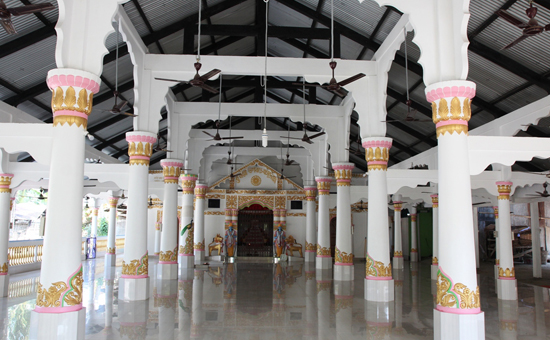 Prayer Hall
Prayer Hall
Also read Satra Culture in Assam
Majuli is the centre of Vaishav culture in Assam.
Sanjeev Nayyar wrote in eSamskriti, “Sankaradeva ushered in the Neo-Vaishnavite movement in this part of the country making Bhagawata the principal medium to serve the
people. He used songs, dance, music and bhaona (drama) as a
medium through which the common man was made to understand the essence of bhakti
ras (devotion). He thereby established the ‘Ek Saran Naam Dharma’. The primary basis of Sankaradeva’s philosophy is worshipping a single deity - Absolute Brahma. In order to help in realization of Brahma in Vedanta he made Krishna (in Bhagawata) as the single deity. In order to help understand the aspects of Krishna, he chose Kishna naam (Chanting of Krishna) as its basis. He said that Krishna naam can fulfil the aim of true human beings through Kirtana (chanting).”
Also read Teachings of Sankaradeva
Three
types of Bihu festival forms the highlight of the Assamese culture that
revolves around their people who are traditionally craftsmen, artists,
sculptors, masons, weavers, spinners, potters, goldsmith, artisans of ivory,
wood, bamboo, canes etc have flourished since time immemorial.
Gamocha is the cultural symbol besides
the tamol paan (areca nut and betel
leaf). Gamocha is a white rectangular cotton hand woven cloth with primarily a
red border on three sides and red woven motifs on the front. In addition to red
other colours are also used. It is also used as a towel, as a waist or a loin
cloth. Bihu dancers wrap gamocha around the head in knots. It is also hung
around the neck at the prayer hall or thrown over the shoulder to signify
social status or respect and offered as a token of love by all.
A. Bihu Nritya
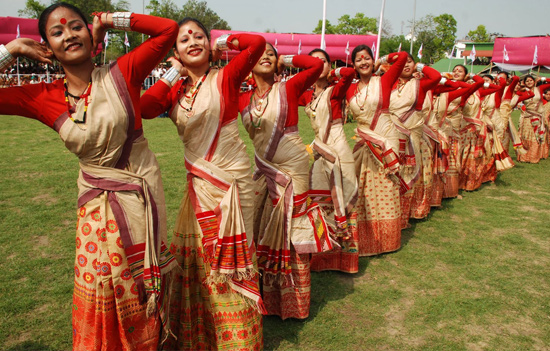
The most
popular folk dance of Assam is the Bihu nritya. It is performed by both boys
and girls and signifies youthful passion, reproduction urge and joy. It forms brisk
dance steps and rapid movements of hands and the shoulder. The dancers wear tight
clothes in order to move and dance properly. They move to the music of the dhol
(dholak), Penpa, Gagava and Banh (flute) etc.
The first
endorsement of the Bihu dance was in 1694 when Ahom King Rudra Singh invited
Bihu dancers to perform at Ranghar fields on the occasion of Rongali Bihu
festival
Also read The Bonfires of Magh Bihu
B. Barpeha Bhortal Nritya
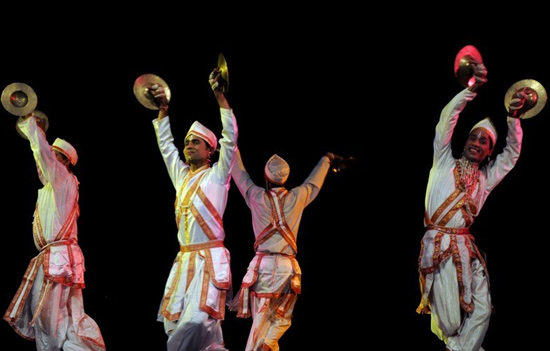
This is
performed by dancers who believe in Sankari culture, otherwise known as the
followers of Lord Shiva. It is essentially performed by men as they carry the
drums tied on the waist along with cymbals and move with the percussion rhythm.
This is performed in festivals in Berpeta and Guwahati.
C. Tea folks Jhumur dance
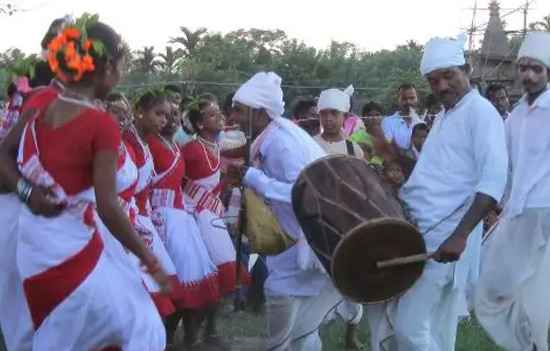
As the
title suggest the Jhumur dance is performed by those who work in tea
plantations hence the complete process of growing ,cultivating and plucking the
tea leaves in demonstrated in this dance. It is performed by boys and girls and
also called Chah Bagana Jhumur Nritya.
The dancers clasp each other on the waist and dance to different rhythms
D. Bagurumba
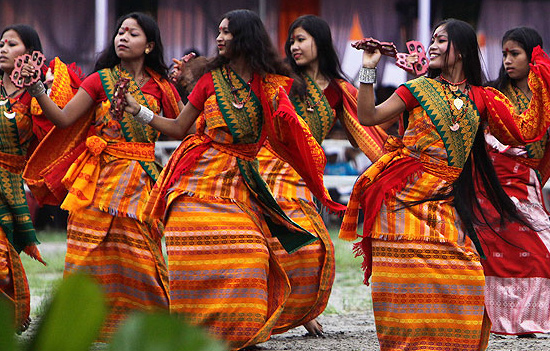
This
dance is mainly performed by the Bodo community. It is a slow dance with
outstretched hands to signify longing and bonding for each other. With the
traditional Bodo attire this dance is particularly prevalent in Kokrajhar,
Bongaigaon, Nalbari, Dalrang and Sonitpur district in the Bwisagu festival in
Bishuba Sankirtan (mid-April). The movements incorporate nature in varied
facets like the movements of butterflies, birds, animals etc.
E. Deodhani
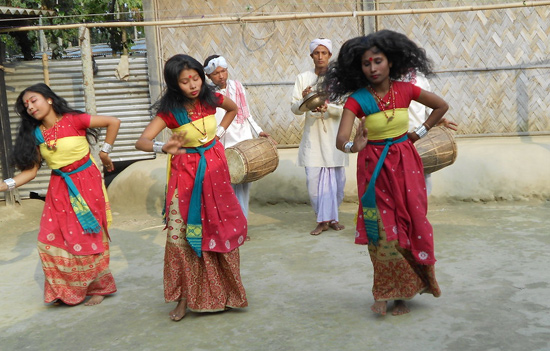
Deodhani
is a ritualistic dance pertaining to the worship of snake goddess Manasa. The Deodhani girl is inspired by
the percussion drum music and the flute. The dance has semi-classical
movements and also the trance and particularly prevalent in Mangaldoi and
Southwest Kamrup areas. The dance begins with propitiating gods like Shivji and
concludes with tributes to Goddess Lakshmi.
It is performed
in Kamakhya temple where devotees paint their bodies in red colour and
offer goat or pigeon to Maa Kamakya. It is believed that if you participate in
this festival you will be bestowed with superficial power by Goddess Kamakhya.
Also read Folk Dances of Assam performed at
Kaziranga Bio-diversity Park
Bohang Bihu is the spring
festival of Assam
2. Arunachal Pradesh
As the
name suggests Arun is the Sun, hence Arunachal is in the lap of sun,
endowed with natural beauty, flora and fauna.
A. Buiya
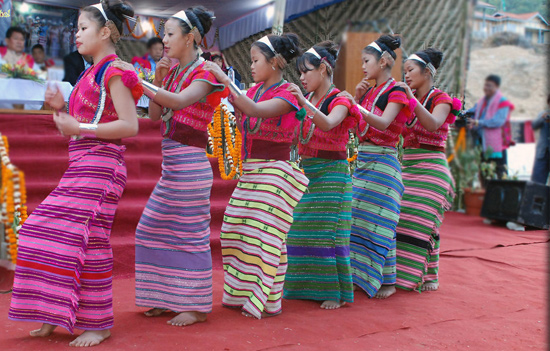
Buiya is
a particular tribe i.e. also known as Digaru Mishima. This is a joyful
dance performed by both men and women, particularly prevalent in the festival
in Tazampu, Duiya and Tanuya areas. The dance is effortless and skipping
at times. While the women are supposed to be more graceful and gentle, the male
counterparts move in faster and vigorous steps. They dance to the
music of drum, gong and cymbals.
B. Chalo
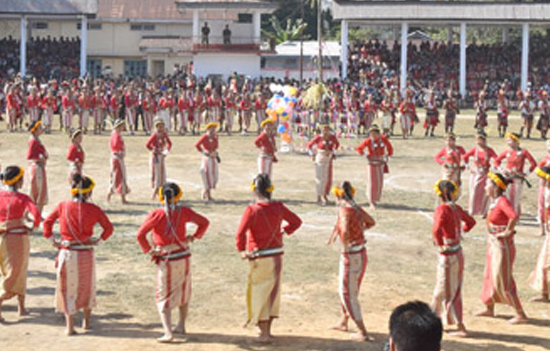
Chalo is
part of the most awaited festival Chaloloku
i.e. held in October-November. It is performed during the harvest season by
locals of all age groups. The men wear headgear which is decorated with white
feathers, armlets, metal rings and ear rings. The dance is performed by the
nocte tribe.
C. Wancho
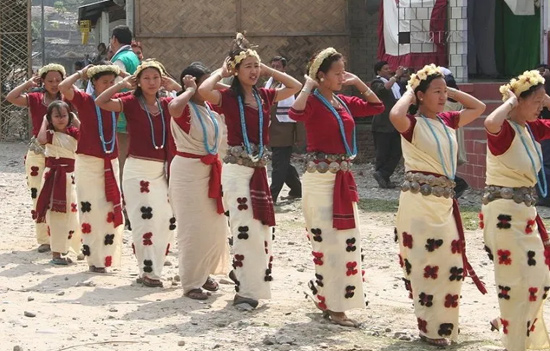
Wancho is
performed by the Oriah tribe. It
starts with a prayer for the well-being of mankind. The dance is performed with
entertaining music as they dance with uniformity to reveal the spirit of
solidarity. The male dancers dance with a basket of cane tied around the waist,
decorated with wild boar tail hair, animal skulls, shells and colorful beads
with bells attached.
3. Manipur
Music and
dance forms an integral part of the lifestyle for the people in Manipur. Any
occasion, social or religious, the Manipuri dances are always performed. While
the Manipuri dances are classified as classical dances they have a firm folkish
inheritance, with limited light hearted steps that move in a circular manner
with a graceful swaying of the hands accordingly. Manipuri culture draws
heavily with the Krishna folk lore and hence follows the Vishnu Sampradaya.
Also read Rajrishi Bhagyachandra and Bhakti
in Manipur
Lai Haroba
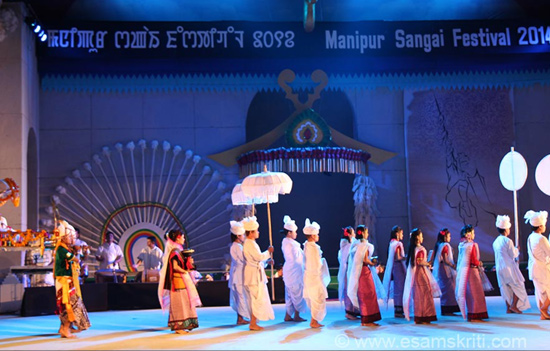
U see the most important festival of Manipur called LAI HAROBA. “It has its origin in pre-Vaishnavite period. This is a rigidly observed ritual that begins towards the end of the year and moves into the New Year i.e. in March-April. "Celebrated in honor of the sylvan deities known as Uman. With the arrival of Vaishnavism in the 15th century A.D., new compositions based on episodes from the life of Radha and Krishna were gradually introduced.” PENA, a stringed instrument is used in this festival.
It means
the merry making of the gods. With music and songs sung in praise of the gods
in the Manipuri language, dancers dance with lot of joy and excitement,
revealing the merry making of gods.
Jagoi
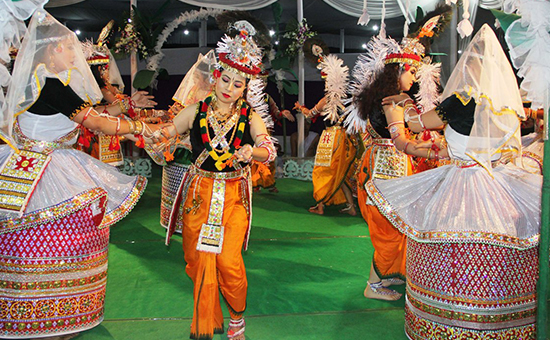 Krishna Leela, Sangai Festival 2014.
Krishna Leela, Sangai Festival 2014.
It is
predominantly the Ras Leela dance which is part of the Maharaas,
considered a rare spectacle as each Gopi dances with Krishna, hence there are
several Gopis dancing with several Krishnas. This is a rare visual imagery
that reveals the message of love and bonding with Krishna and the Gopis with a
philosophical underlining that establishes the relation with the human soul for
the divine soul or Parmatma.
Pung Cholom
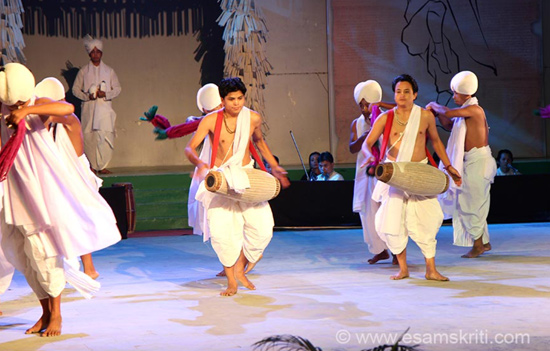 Performed in every traditional religious ceremony. Manipuri classical drum is called Pung. On left of pic what artist are holding in their hands brass bit is called Mandila.
Performed in every traditional religious ceremony. Manipuri classical drum is called Pung. On left of pic what artist are holding in their hands brass bit is called Mandila.
“Pung Cholom is also known as Mrindanga Kirtan or Dhumal or Dram dance. This dance is performed by only males either as integral parts of Nata Sankirtan or independently in front of social gathering. When it is a part of Nata, two players participate in its performance, but as an independent dance performance at least 14 players follow the sequence of Nata Sankirtan."
“Pung Cholom or Drum Dance is a visual interpretation of the various rhythmic patterns played on the pung. In this dance, the drummer identifies completely with the intricate rhythms he plays on the drum and expresses it through corresponding body movements and footwork.”
It is
quite an exciting dance as it is the dance with drums, the dancers move along
with the rhythm of drum and also perform acrobatic feats as they rotate along
with the drums in a circular pattern, a rare spectacle as you feel that they
are almost flying.
Thang ta
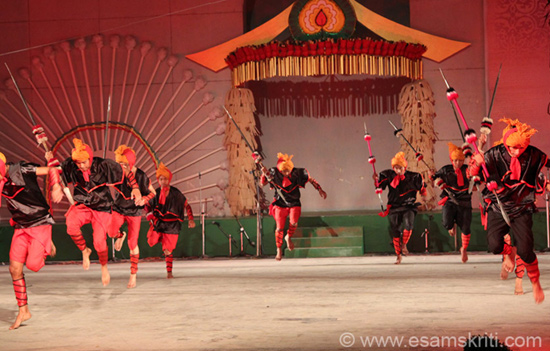 Thang Ta is traditional martial art of Manipur that has been carried on for generations.
Thang Ta is traditional martial art of Manipur that has been carried on for generations.
It is the
martial dance form of Manipur, performed primarily by men demonstrating varied
techniques of the defence and attacks to the opponents, with or
without the usage of varied weapons.
Some
other dances of Manipur.
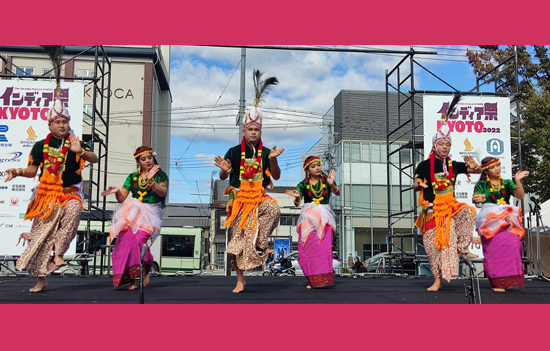 Thoughal Jagoi dance performance at Kyoto, Japan. Pic by Sanatomba Singh.
Thoughal Jagoi dance performance at Kyoto, Japan. Pic by Sanatomba Singh.
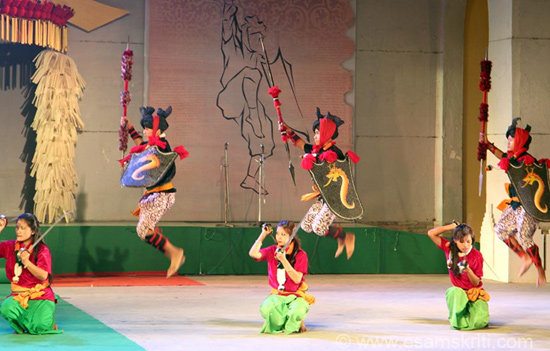 Thang Chungoi Yanaaba. This is an art of fighting of 2 warriors with sword and shield. From here on all pics of Sangai Festival 2014.
Thang Chungoi Yanaaba. This is an art of fighting of 2 warriors with sword and shield. From here on all pics of Sangai Festival 2014.
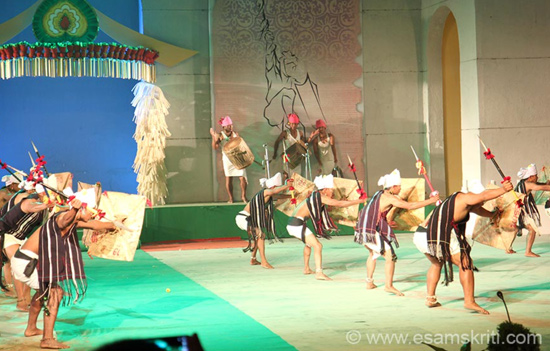 Lho Sha dance.
Lho Sha dance.
Lhou Sha Dance-Maring Tribe. It is a performed after victory in battle or fight. “The Lhou Sha is a war dance performed at every confrontation between two villages. The dance form has been preserved as part of the tradition of the Maring community of Manipur and marks the conclusion of significant festivals. The dance, which was initially performed by men only, has evolved into a folk art, including the tribe’s womenfolk in its ambit.”
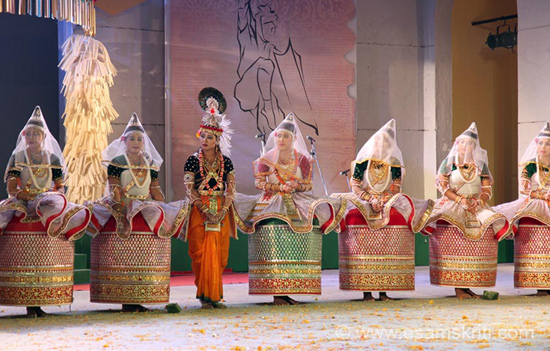 U see Sri Krishna with Gopis.
U see Sri Krishna with Gopis.
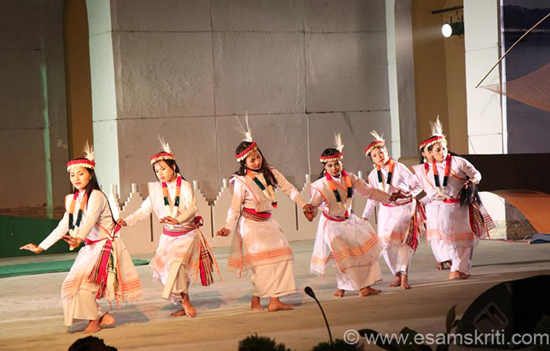 Meibi dance.
Meibi dance.
“Despite the prevalence of Vaishnavite faith, every part of Manipur has a guardian deity, who still commands the devotion of the state’s denizens. Through this dance, the maibis invoke the deities and exhort them to bless the entire community. Depicting the creation and evolution of life, the dance is an ultimate offering to the guardian deities.”
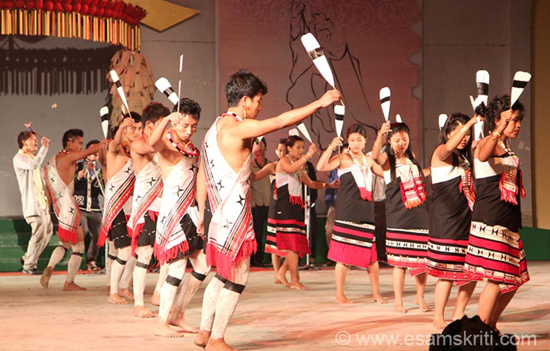 Dance by tribe from Tamenglong district.
Dance by tribe from Tamenglong district.
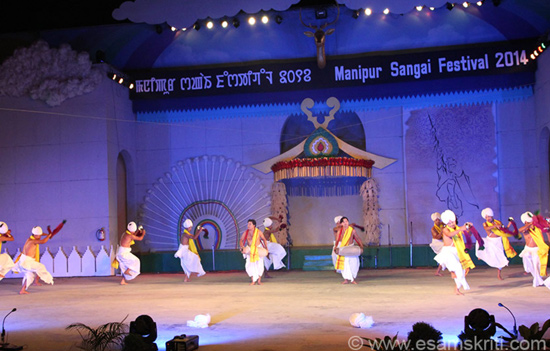 Nata Cholam.
Nata Cholam.
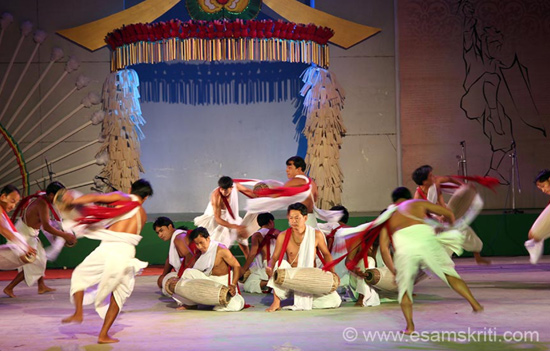 Taal Nachom - Performance by Manipuri Jagoi Marup, a leading Manipuri Dance performing troupe founded by late Guru Padmashri Amubi Singh in the year 1963.
Taal Nachom - Performance by Manipuri Jagoi Marup, a leading Manipuri Dance performing troupe founded by late Guru Padmashri Amubi Singh in the year 1963.
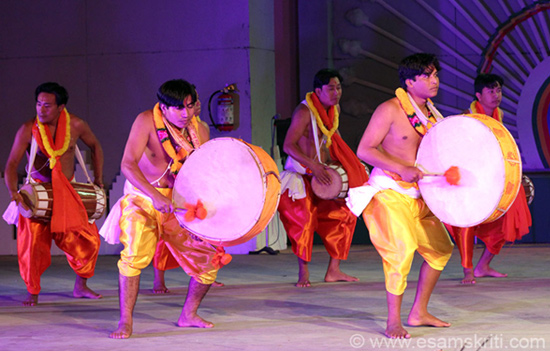 Dhol Dholak Chalom.
Dhol Dholak Chalom.
“Age old festival of Yaoshang was merged with Holi, the festival of colours, on introduction of Vaishnavism. It is accompanied by devotional songs and dances.
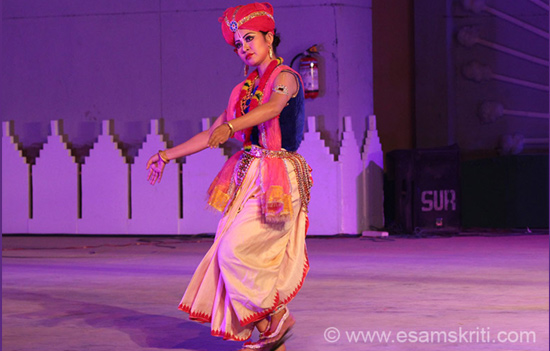 Taal Nichom.
Taal Nichom.
Post advent of Vaishnavism, Sankirtan or the worship of Lord Krishna and Radha through the medium of music and dance, became the most powerful expression of Bhaktirasa.”
To see
performances of all Manipuri dances see Sangai Festival Album 1 and 2
Read Manipuri Dance a
Journey
4. Nagaland
Nagaland is known for its tribal culture and its varied tribes. The
festivals are known as Moatsu, Tuluni and Tsukhenyie. The most popular festival
is the Hornbill Festival i.e. held in the month of December. There are
several types of dances known as Modse, Agurshikukula, Butterfly dance,
Aaluyattu, Sudal Kekai, Changai dance, Kuki dance, Leshalaptu, Khambatim, Mayur
dance, Monyaasho, Rengma, Seecha, Kukui, Kucho, Shankari and Myasha. The most
popular ones are the War dance and the Zeliang dance.
Album Hornbill Festival, pics are
by tribe
A. War dance
The war dance is performed by the Changto or Sualua Chang tribe, similar
to the Zeliang dance. Men and women participate in this dance. The men are seen
with war weapons like the dao, shield and spear. The dancers are in the
traditional colourful attire and the dance consists of chanting, clapping
and shouting of words, thumping of feet and the dancers dance to the
rhythm of the drum in a synchronised manner.
B. Zeliang dance
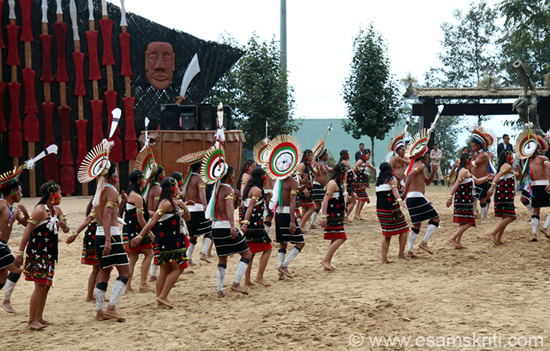
This is primarily performed by the Zeliang tribe involving men and
women and is a joyous dance with clapping and chanting, performed to the
drum music. This dance portrays unity and a sense of bonding. Everyone dances
together with uniformity.
C. Hunter dance
Another popular dance is the hunter dance. This dance is quite
interesting and exciting as it portrays the complete process of hunting. As to
how one starts slowly and steadily in order to track the prey and
after the hunt is done, they rejoice happily and cook the prey on a bonfire. Movements
are slow, vigorous and fast actually are according to the scenes depicted, moving
with typical rhythmic syllables and words that is quite exciting for the
dancers and the audience as well.
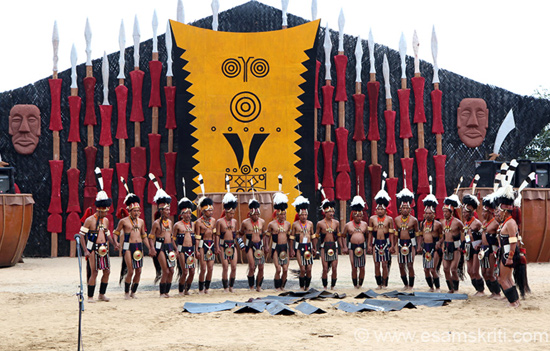 Phom tribe dance.
Phom tribe dance.
5. Tripura
A. Garia dance
One of the main occupations of the Tripuris is farming hence there are dances that portray the various facets of farming like the Garia dance. After the sowing of seeds and Jhum (cultivation) in mid-April, they pray to God "Garia" for a rich harvest. The prayer and salutations continue for seven days. Besides the salutations to God, the Garia dance is known for its complete process of cultivation and growth for a rich harvest.
B. Hozagiri dance
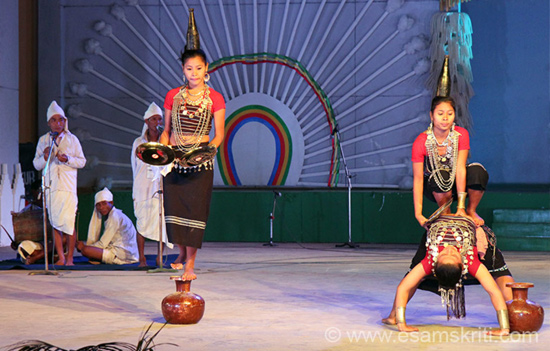
The hozagiri dance is performed by the Reang tribe. It is a balancing
act with some dance moves hence you need a lot of practise to master this
act. The Reang belle dancers stand on the earthen pitcher with a
bottle on the head with a lighted lamp on it, they slowly start moving and
dancing on the top of the earthern pitcher, which is not an easy task.
The dancers dance to the tune of the Khamb, flute of Bamboo and cymbals
and the dancers are decorated with black Pachra and coin rings
that cover the entire upper region, rings of coins in
the ears and are adorned with fragrant flowers.
C. Cheraw dance
According to the Tripura government site, “The Darlong reposes faith in after life. They believe that man is destined to go to Heaven after death. Incidentally, they think that if a pregnant woman dies, she feels it very difficult, with all her physical strains, to track the long journey to Heaven. Hence at the last stage of her pregnancy - in fact just at the time or immediately prior to delivery all her relatives perform this 'Cheraw' dance in-group throughout day and night so as to instil confidence in the mind of that woman. They are firm in their belief that even if the woman dies at this juncture. It will be possible for her to go Heaven with the courage and confidence together with joy gained through the sound of bamboo as the rhythm of the dance produced till her death.”
To know about all Folk dances of
Tripura
6. Meghalaya
As the
name suggests it is considered the home of the clouds, hence the name Meghalaya.
A. Loho - Chipiah dance
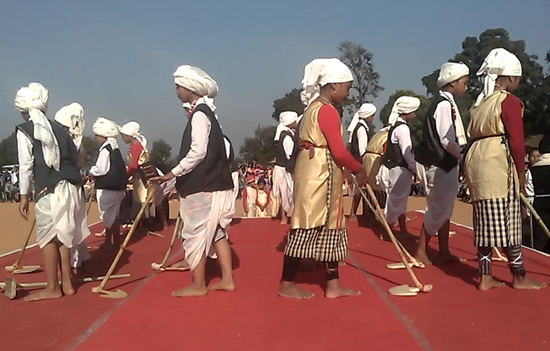
This is a
dance of joy, happiness and well-being. It is performed in a group with one girl
and two boys by the Pnar tribe in the Behdienklam festival. This
dance is performed without any musical instrument but with recitation of a
song sung by singer with sweet voice.
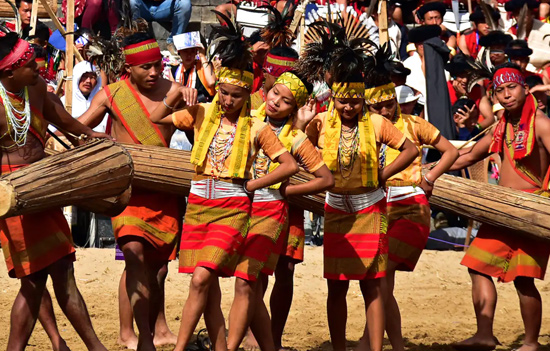 Wangala dance.
Wangala dance.
Wangala
is a harvest dance performed by the Garos tribe with 100 drums being played at
the same time. It is considered a tribute to Saljong - Sun god of
fertility. This dance marks the end of toil and labour with the harvest and
good output of the fields.
The other
folk dances of Meghalaya are Nongkrem Shad Suk Mynsiem and Dorsegata.
7. Mizoram
A. Chailam
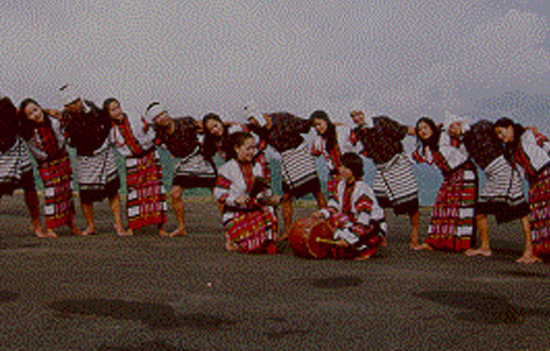
Chailam dance is performed in the 'Chapchar Kut' festival of the Mizos in which men and women stand alternatively in circles facing each other as the women hold the waist of the man and the man holds the women's shoulder as they dance with joy and unity.
B. Cheraw
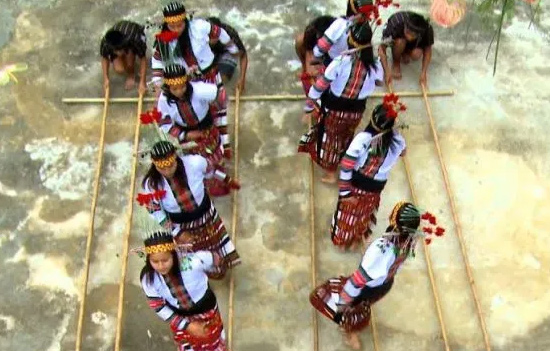 Very popular bamboo dance.
Very popular bamboo dance.
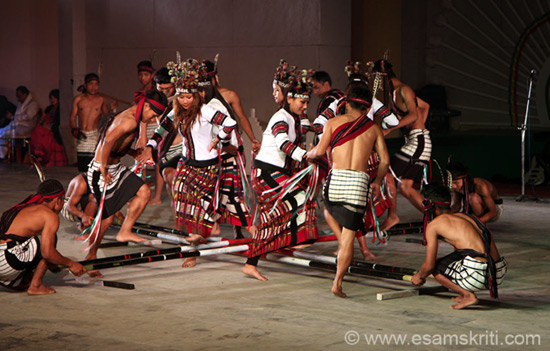 Bamboo Dance at Sangai Festival.
Bamboo Dance at Sangai Festival.
This is
one of the most popular folk dances of Mizoram also known as the Bamboo dance.
This is an exciting dance by men and women. While men hold the bamboos
horizontally on the ground women jump and match the beats while dancing,
placing their feet in quick succession. This dance needs lot of practise,
otherwise you could hurt yourself. The same act is repeated when women hold the
bamboos and men skip and jump in between the bamboos.
C. Khuallam Dance
Khula means the guest and lam means dance. Hence in Khuallam dance friends from neighbouring villages are invited to participate in this dance. They dance to the sound of the Darby and the costume worn by the women are hand woven and called 'punadum'.
D. Chhiehlam dance
Chhieh
means the exclamation of joy and Lam means to dance. This dance reflects the
rich culture of the elite class. The dancers sit in a circle on their heels and
one dancer in the middle recites a single stanza with three lines that reveals
the life style of the rich class. The women are beautifully attired with
exuberant costumes and jewellery.
To know all about Dances of
Mizoram
To see pictures of
Classical and Folk Dances of India
Also read
1.
Folk dances of
South India
2.
Folk dances of
Odisha
3.
Kalbelia folk
dance of Rajasthan
4.
Adivasi dances of
India
5.
Folk dance forms
of Assam
6.
Folk dance
performances at Shilp Gram Udaipur